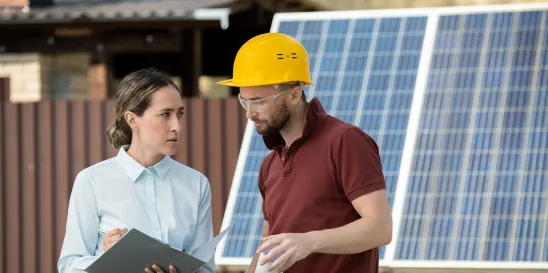On Oct. 19, 2023, the portal to apply for the Low-Income Communities Bonus Credit under Section 48 will be open. Most developers will be eligible for at least a 50% investment tax credit (ITC). This 50% ITC would consist of a 30% base credit and a 20% bonus credit for eligible solar and wind facilities that are installed in low-income communities (a qualified low-income residential building project). A 50% credit on the cost of your solar property is a significant benefit (see example below).
If you are interested in obtaining these credits, it is best to start preparing to apply now. The 20% bonus credit is allocated through a competitive process, and applications submitted on the portal within the first 30 days will be treated as submitted on the same date and at the same time, and on a rolling basis thereafter.
Key Provisions/Benefits:
- The ITC is claimed 100% upfront when the property is placed in service. The ITC reduces the federal income tax liability by the applicable percentage of the cost of a solar system that is installed during the tax year.
- The ITC can be specially allocated to the general partner if the tax equity investor only has an appetite for low-income housing tax credit (LIHTC) or otherwise.
- Labor requirements including paying prevailing wages are waived for projects with a maximum net output of less than 1 megawatt of electrical energy. Most solar installations at LIHTC properties are below 1 megawatt which equates to the electricity consumed by 400 to 900 homes in a year.
- No reduction in LIHTC eligible basis by the amount of the ITC (IRA change).
- Any costs related to the solar system continues to increase your eligible basis.
Applications/Timing:
- Revenue Procedure 2003-27 provides the process under § 48(e) to apply for an allocation of environmental justice solar and wind capacity limitation.
- Applications will require information such as the applicable category, ownership, location, facility size/capacity, whether the applicant or facility meet additional selection criteria, and other information.
- The landing page for the application process is: Low-Income Communities Bonus Credit Program | Department of Energy.
- Department of Energy (DOE) will evaluate submitted applications based on the established capacity limitation per program year and provide a recommendation to the Internal Revenue Service (IRS) regarding whether to award an applicant an amount of capacity limitation.
- The IRS then considers DOE’s recommendation and issues a capacity limitation allocation award letter or a denial letter for facilities that are not accepted into the program.
To illustrate how the ITC is calculated and applied at a business, consider a business that commenced construction of a solar PV system in 2023, placed it in service in 2025, and uses the calendar year as its tax year. The 500-kW system costs $1 million and has a capacity factor of 20% in the first year. The net effect of claiming the ITC, bonus depreciation, and accelerated depreciation on its 2025 tax liability is a reduction of approximately $582,845 in 2025 tax liability. The business will continue to claim accelerated depreciation deductions for tax years 2026, 2027, 2028, 2029, and 2030 — but the specific depreciation rate will vary by year.




 />i
/>i

